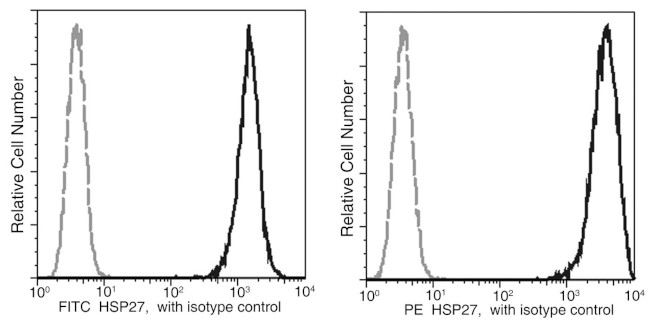Search Thermo Fisher Scientific
图: 1 / 2
HSP27 Antibody (MA5-40991) in Flow


产品信息
MA5-40991
种属反应
宿主/亚型
Expression System
分类
类型
克隆号
抗原
偶联物
激发/发射光谱
形式
浓度
纯化类型
保存液
内含物
保存条件
运输条件
RRID
产品详细信息
May be stored for twelve months without detectable loss of activity. Protect from prolonged exposure to light and do not freeze. Sodium azide is toxic to cells and should be disposed of properly so flush with large volumes of water during disposal.
靶标信息
In response to adverse changes in their environment, cells from many organisms increase the expression of a class of proteins referred to as heat shock or stress proteins. HSPB1 (heat shock protein beta-1 or HSP27) is a small heat shock protein which functions as a molecular chaperone that maintains denatured proteins in a folding-competent state. It plays a role in stress resistance and actin organization. Through its molecular chaperone activity, HSP27 regulates numerous biological processes including the phosphorylation and the axonal transport of neurofilament proteins. Mutations in the gene can result in Charcot-Marie-Tooth disease 2F and Neuronopathy distal hereditary motor 2B.
仅用于科研。不用于诊断过程。未经明确授权不得转售。
How to use the Panel Builder
Watch the video to learn how to use the Invitrogen Flow Cytometry Panel Builder to build your next flow cytometry panel in 5 easy steps.
篇参考文献 (0)
生物信息学
蛋白别名: 28 kDa heat shock protein; DKFZp586P1322; epididymis secretory protein Li 102; Estrogen-regulated 24 kDa protein; Heat shock 27 kDa protein; heat shock 27kD protein 1; heat shock 27kDa protein 1; Heat shock protein; Heat shock protein beta-1; Heat shock protein family B member 1; HS; HSP; HSP 27; HspB1; Phospho-HSP 27; SRP27; Stress-responsive protein 27
基因别名: CMT2F; HEL-S-102; HMN2B; HS.76067; Hsp25; HSP27; HSP28; HSPB1; SRP27
UniProt ID: (Human) P04792
Entrez Gene ID: (Human) 3315




